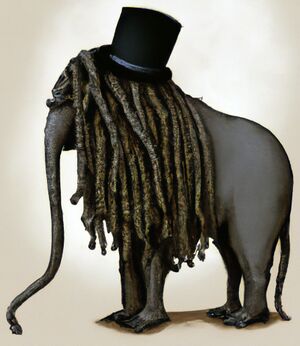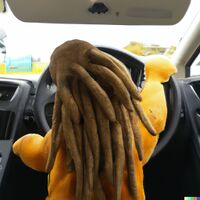Rastadon
The Rastadon (Mamut rastadonis) is a mammalian species often confused with the more common Mastodon. The Rastadon was more intelligent, had a more complex social structure, and showed many other attributes usually associated with humanity, such as their own religion and communual smoking. The species now has only one living member and will go extinct when he rolls up his last reefer.
Discovery
The Rastadon was discovered on February 3, 2007, by one Dr. Professor Ima Walrus, who got his Ph.D. in Zoology at Gotham University, as well as Tom Freebird, who had a B.A. in Sociology, and a minor in Taylor Swift, from Michigan Tech. Their historic discovery was found fifty miles north of Rastos, Nebraska. To date, only one skeleton of a Rastadon has ever been found, where it is currently still in active use. After many tests, Dr. Professor Walrus and Mr. Freebird found that the Rastadon's turn-offs included tobacco cigarettes, uniforms, sirens, and corporate life. Whereas its turn-ons included: pistachio ice cream, herbal medicine, large hollow plastic figurines with pipes sticking out of them, and snack foods.
Physical appearance
Rastadons look strikingly similar to Mastodons, so it is no surprise that the former is often mistakenly referred to as the latter. However, there are some key differences that will enable anyone to immediately tell the difference between the two. The largest and most noticeable difference is a large, colorful growth rooted to the top of the Rastadon's head. This portion of the anatomy is referred to as the Rastos Hattorus. Also growing out of the head, just beneath the Rastos Hattorus, are many long, black, tendril-like growths, individually referred to as Rastos Lockus, though collectively, they are commonly known as rasto-locks.
Behavior
The Rastadon has evolved to the point of making medicinal herbs part of its daily life. It uses these herbs to alleviate pain, discomfort, and awkwardness; also to kill time, get a good buzz, and goose the Muse for that future album. Found near the Rastadon specimen was a primitive tube-like structure likely used to dessicate the herbs and purify the resulting odors, which the Rastadon uses in an ancient type of aromatherapy.
Outlook
The Rastadon was long thought to be completely extinct. However, researchers recently discovered a single living member of this majestic, rare species. Oddly, this Rastadon is known not as 'Don' but as 'Bob'.
As Bob is the last living specimen of Rastadon, the Scientific Community is adamant to save at least part of his gene pool — perhaps by cloning, or cross-breeding him with an elephant. However, the latter option, though easier to execute, might dilute the Rastadon's genes and lose the 'essence' of the species; for Bob, a case of No Cloning, No Cry.
Bob is currently in the custody of a private investigation firm, Blogosphere International, which keeps him in isolation to prevent sabotage. The company's website has not released any details on the Rastadon's current condition, and has not yet responded to questions, despite being repeatedly pestered via email. In response to the constant harassment, the company has filed a lawsuit on the author of this here article, who would very much like your support by please donating to his PayPal account. No? Worth a shot.
| Featured version: 05 May 2024 | |
| This article has been featured on the main page. — You can vote for or nominate your favourite articles at Uncyclopedia:VFH. | |


